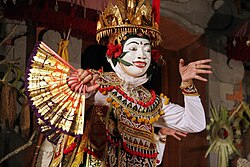 Cakalele dance performance | |
| Native name | Tari cakalele |
|---|---|
| Inventor | Eastern Indonesia |
| Origin | Indonesia |
| Cakalele dance |
|---|
|
| Burma |
| Cambodia |
| Indonesia |
|
| Laos |
| Malaysia |
| Philippines |
| Singapore |
| Thailand |
|
| Vietnam |
Cakalele dance (pronounced "cha-ka-leh-leh", spelled tjakalele by the Dutch) is a war dance from North and Central Maluku in Indonesia. [1] Hybrid versions also exist among the natives of Sulawesi ( Kabasaran dance or Sakalele of the Minahasan), [2] East Nusa Tenggara (Abui Cakalele from Alor), [3] the Tanimbar Islands,[ citation needed ] and Fakfak ( Mbaham-Matta's Cakalele Mbreh). [4] The dance is performed by men, two of whom represent opposing captains or leaders while the others are the warriors supporting them. After an opening ritual, the captains engage in a mock-duel with a spear (sanokat) and a long parang (lopu) while their supporters use a lopu in the right hand and a long shield in the left hand. [5] The shield is referred to as a salawaku, or by a local name such as the Tobelo o dadatoko. [6] The cakalele originated as a way for the warriors to celebrate after a successful raid. Dancers dress in full warrior costume and are backed by the rhythm of the drum ( tifa ), gong, and fife ( suling ).












